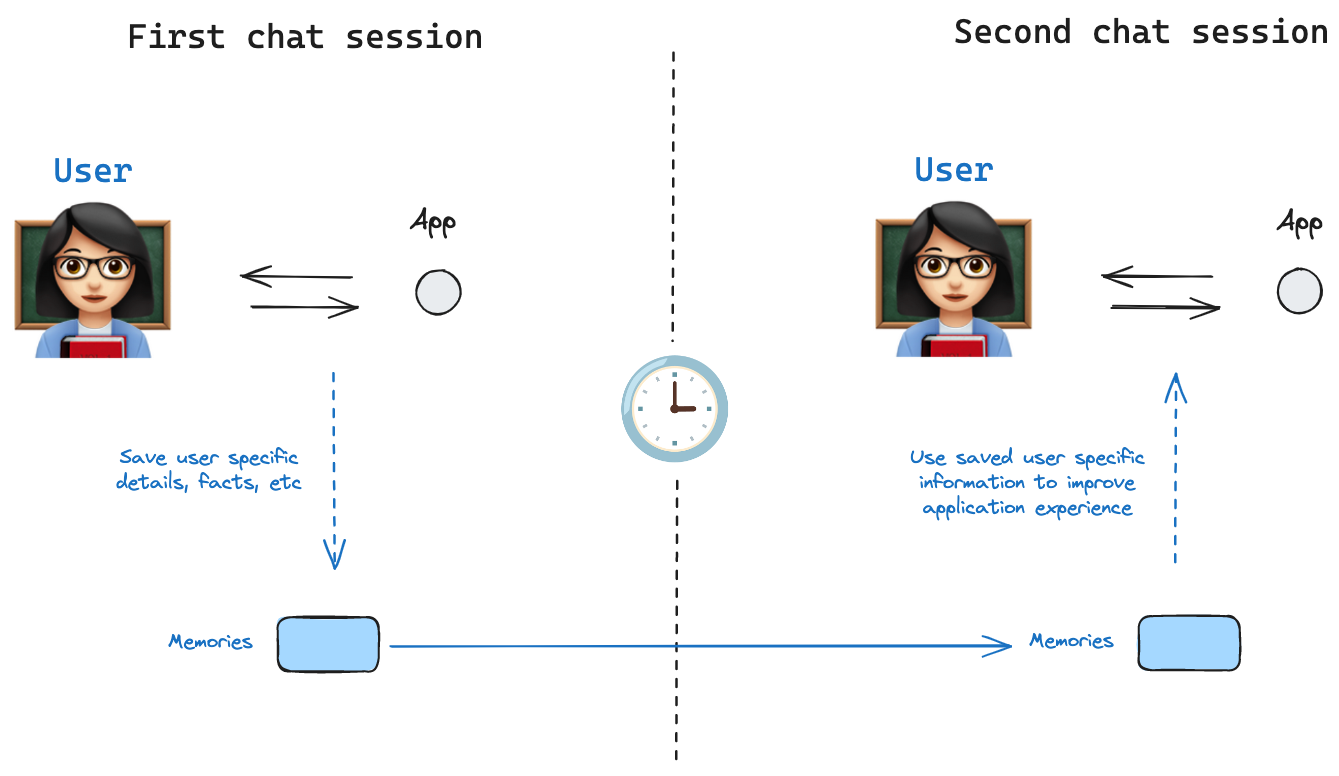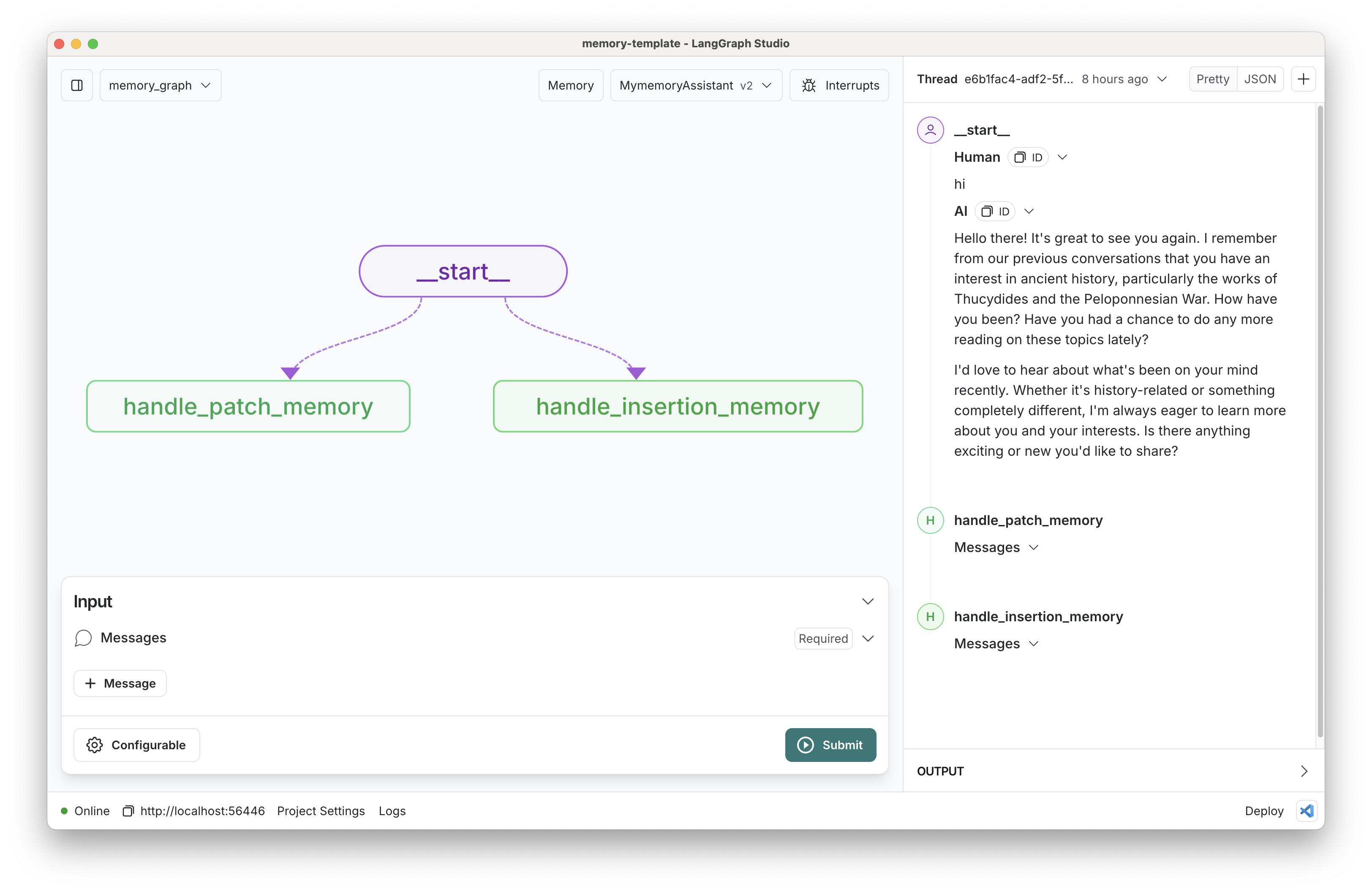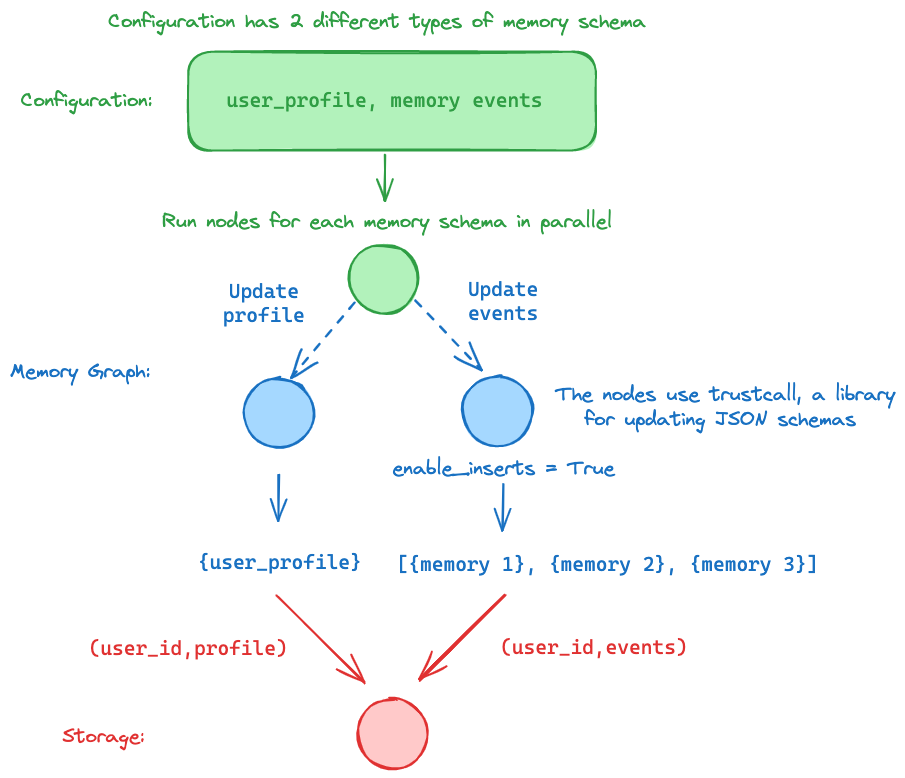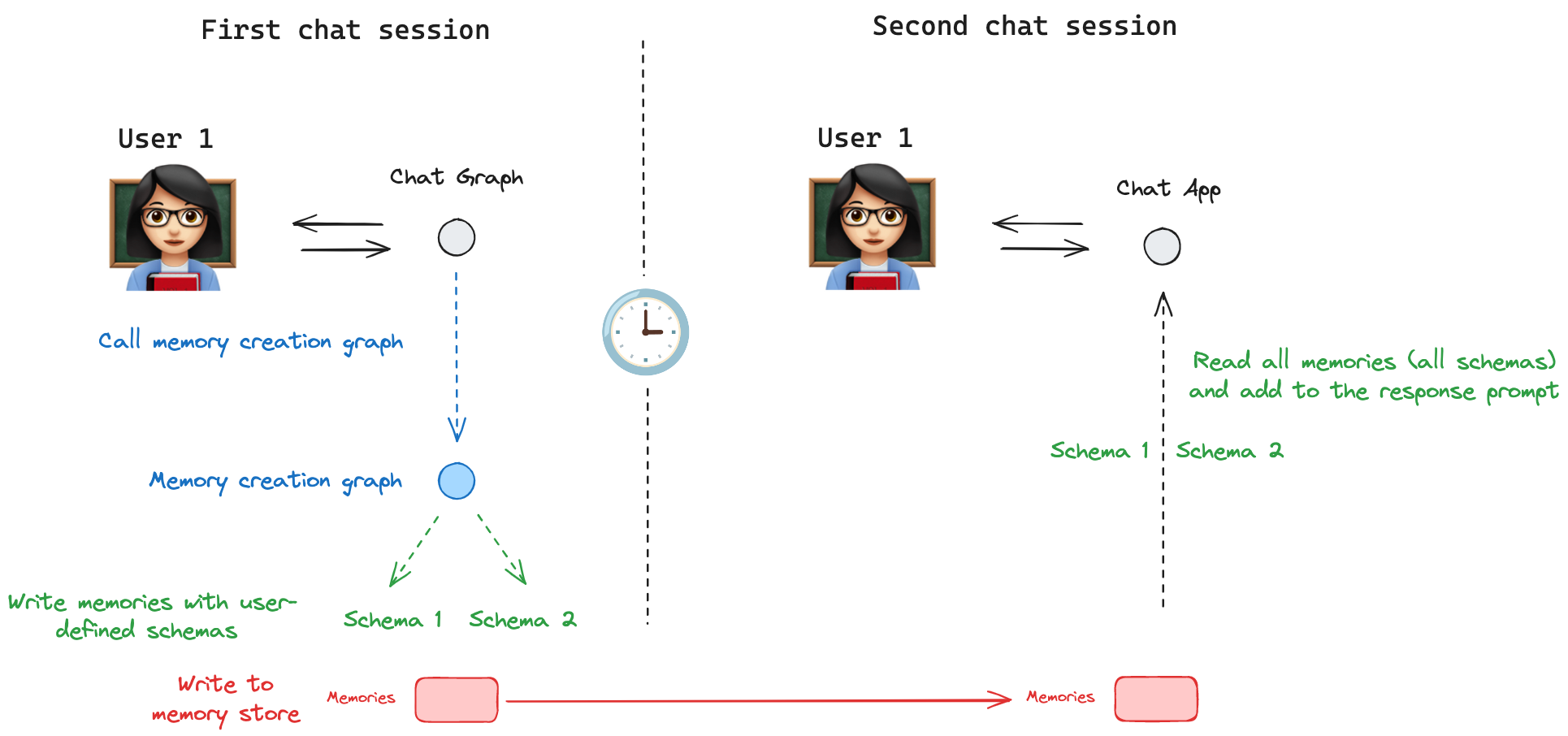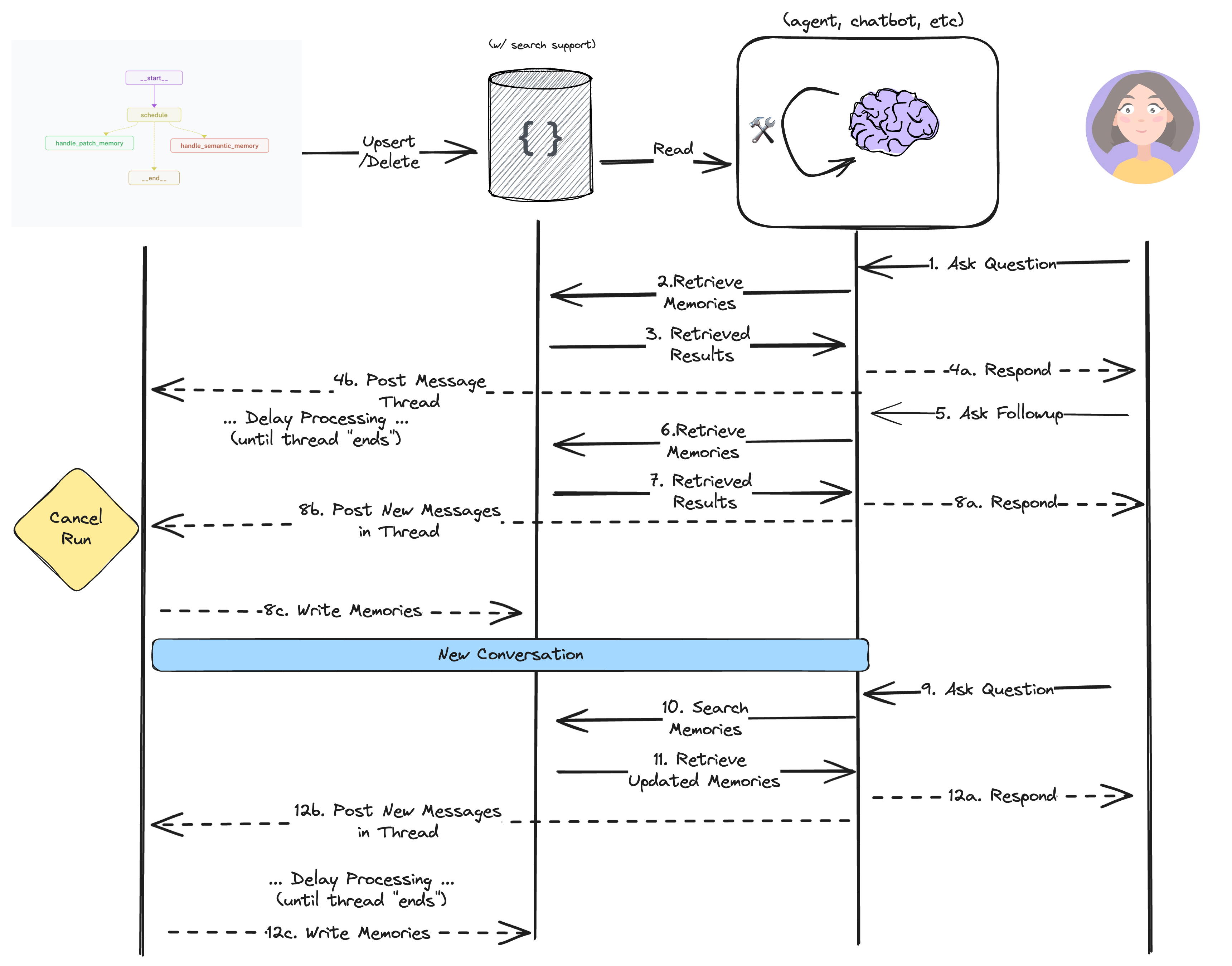Memory lets your AI applications learn from each user interaction. It lets them become effective as they learn from mistakes and more engaging as they adapt to personal tastes. This template shows you how to build and deploy a long-term memory service that you can connect to from any LangGraph agent so they can manage user-scoped memories.
Create a .env file.
cp .env.example .envSet the required API keys in your .env file.
The defaults values for model are shown below:
model: anthropic/claude-3-5-sonnet-20240620Follow the instructions below to get set up, or pick one of the additional options.
To use Anthropic's chat models:
- Sign up for an Anthropic API key if you haven't already.
- Once you have your API key, add it to your
.envfile:
ANTHROPIC_API_KEY=your-api-key
To use OpenAI's chat models:
- Sign up for an OpenAI API key.
- Once you have your API key, add it to your
.envfile:
OPENAI_API_KEY=your-api-key
Open this template in LangGraph studio to get started and navigate to the chatbot graph.
If you want to deploy to the cloud, follow these instructions to deploy this repository to LangGraph Cloud and use Studio in your browser.
Try chatting with the bot! It will try to save memories locally (on your desktop) based on the content you tell it. For instance, if you say "Hi I'm will and I like to hike.", it will treat that content as worthy of remembering.
If you pause the conversation for ~10-20 seconds, the long-term-memory graph will start. You can click the "Memories" button at the top of your studio (if you've updated your app to a recent version) to see what's been inferred.
Create a new thread using the + icon and chat with the bot again.
The bot should have access to the memories you've saved, and will use them to personalize its responses.
An effective memory service should address some key questions:
- What should each memory contain?
- How should memories be updated? (and on what schedule?)
- How should your bot recall memories?
The "correct" answer to these questions can be application-specific. We'll address these challenges below, and explain how this template lets you flexibly configure what and how memories are managed to keep your bot's memory on-topic and up-to-date. First, we'll talk about how you configure "what each memory should contain" using memory schemas.
Memory schemas tell the service the "shape" of individual memories and how to update them. You can define any custom memory schema by providing memory_types as configuration. Let's review the two default schemas we've provided along the template to get a better sense of what they are doing.
The first schema is the User profile schema, copied below:
{
"name": "User",
"description": "Update this document to maintain up-to-date information about the user in the conversation.",
"update_mode": "patch",
"parameters": {
"type": "object",
"properties": {
"user_name": {
"type": "string",
"description": "The user's preferred name"
},
"age": {
"type": "integer",
"description": "The user's age"
},
"interests": {
"type": "array",
"items": { "type": "string" },
"description": "A list of the user's interests"
},
"home": {
"type": "string",
"description": "Description of the user's home town/neighborhood, etc."
},
"occupation": {
"type": "string",
"description": "The user's current occupation or profession"
},
"conversation_preferences": {
"type": "array",
"items": { "type": "string" },
"description": "A list of the user's preferred conversation styles, pronouns, topics they want to avoid, etc."
}
}
}
}The schema has a name and description, as well as JSON schema parameters that are all passed to an LLM. The LLM infers the values for the schema based on the conversations you send to the memory service.
The schema also has an update_mode parameter that defines how the service should update its memory when new information is provided. The patch update_mode instructs the graph that we should always have a single JSON object to represent this user. When new information is provided, the model can generate "patches", or small updates to extend, delete, or replace content in the current memory document. This type of update_mode is useful if you want strict visibility into a user's representation at any given point or if you want to let the end user directly view and update their own representation for the bot. By defining these specific parameters, we are decideing that this (and only this) information is relevant to track and excluding other information (like "relationships" or "religion", etc.) from being tracked. It's an easy way for us to bias the service into focusing on what we think is important for our specific bot.
The second memory schema we provide is the Note schema, shown below:
{
"name": "Note",
"description": "Save notable memories the user has shared with you for later recall.",
"update_mode": "insert",
"parameters": {
"type": "object",
"properties": {
"context": {
"type": "string",
"description": "The situation or circumstance where this memory may be relevant. Include any caveats or conditions that contextualize the memory. For example, if a user shares a preference, note if it only applies in certain situations (e.g., 'only at work'). Add any other relevant 'meta' details that help fully understand when and how to use this memory."
},
"content": {
"type": "string",
"description": "The specific information, preference, or event being remembered."
}
},
"required": ["context", "content"]
}
}Just like the previous example, this schema has a name, description, and parameters. Notic that the update_mode this time is "insert". This instructs the LLM in the memory service to insert new memories to the list or update existing ones. The number of memories for this update_mode is unbound since the model can continue to store new notes any time something interesting shows up in the conversation. Each time the service runs, the model can generate multiple schemas, some to update or re-contextualize existing memories, some to document new information. Note taht these memory schemas tend to have fewer parameters and are usually most effective if you have a field to let the service provide contextual information (so that if your bot fetches this memory, it isn't taken out-of-context).
To wrap up this section: memory_schemas provide a name, description, and parameters that the LLM populates to store in the database. The update_mode controls whether new information should always overwrite an existing memory or whether it should insert new memories (while optionally updating existing ones).
These schemas are fully customizable! Try extending the above and seeing how it updates memory formation in the studio by passing in via configuration (or defining in an assistant).
In the previous section we showed how the memory schemas define how memories should be updated with new information over time. Let's now turn our attention to how new information is handled. Each update type using tool calling in slightly different ways. We will use the trustcall library, which we created as a simple interface for generating and continuously updating json documents, to handle all of the cases below:
If no memory has been saved yet, trust_call prompts the model to populate the document. It additionally does schema validation to ensure the output is correct.
If a memory already exists, you could simply prompt the model to re-geerate the schema anew on each round. Doing so, however, leads to frequent information loss, especially on complicated schemas, since LLMs are wont to forget or omit previously stored details when regenerating information from scratch if it doesn't happen to be immediately relevant.
To avoid memory loss, your memory schema is placed in the system prompt but not made available as a tool for the model to call. Instead, the LLM is provided a PatchDoc tool. This forces the model to generate a chain-of-thought of 0 or more planned edits, along with patches to individual JSON paths to be modified.
Applying updates as JSON patches helps minimize information loss, save token costs, and simplifies the memory management task.
If no memories have been saved yet, the model is given a single tool (the schema from your memory config). It is prompted to use multi-tool callint to generate 0 or more instances of your schema depending on the conversation context.
If memories exist for this user, the memory graph searches for existing ones to provide additional context. These are put in the system promt along with two two tools: your memory schema as well as a "PatchDoc" tool. The LLM is prompted to invoke whichever tools are appropriate given the conversational context. The LLM can call the PatchDoc tool to update existing memories in case they are no longer correct or require additional context. It can also call your memory schema tool any number of times to save new memories or notes. Either way, it calls these tools in a single generation step, and the graph upserts the results to the memory store.
All of this sounds like a lot of tokens! If we were to process memories on every new message to your chat bot, the costs could indeed mount up. We only really need to process memories after a conversation ends, but in reality we typically don't know when the thread is finished.
As a compromise, our memory service supports debouncing by deferring when it will process memories. Memory updates are scheduled for some point in the future (using the LangGraph SDK's after_seconds parameter).
If the chatbot makes a call second time within that interval, the initial request is cancelled and a new request for memory processing is scheduled.
See this in the code here: chatbot/graph.py.
All these memories need to go somewhere reliable. All LangGraph deployments come with a built-in memory storage layer that you can use to persist information across conversations.
You can learn more about Storage in LangGraph here.
In our case, we are saving all memories namespaced by user_id and by the memory scheam you provide. That way you can easily search for memories for a given user and of a particualr type. This diagram shows how these pieces fit together:
The studio uses the LangGraph API as its backend and exposes graph endpoints for all the graphs defied in your langgraph.json file.
"graphs": {
"chatbot": "./src/chatbot/graph.py:graph",
"memory_graph": "./src/memory_graph/graph.py:graph"
},You can interact with your server and storage using the studio UI or the LangGraph SDK.
from langgraph_sdk import get_client
client = get_client(url="http:...") # your server
items = await client.store.search_items(namespace)The separation of concerns between the application logic (chatbot) and the memory (the memory graph) a few advantages:
(1) minimal overhead by removing memory creation logic from the hotpath of the application (e.g., no latency cost for memory creation)
(2) memory creation logic is handled in a background job, separate from the chatbot, with scheduling to avoid duplicate processing
(3) memory graph can be updated and / or hosted (as a service) independently of the application (chatbot)
Here is a schematic of the interaction pattern:
Memory management can be challenging to get right. To make sure your memory_types suit your applications' needs, we recommend starting from an evaluation set, adding to it over time as you find and address common errors in your service.
We have provided a few example evaluation cases in the test file here. As you can see, the metrics themselves don't have to be terribly complicated, especially not at the outset.
We use LangSmith's @unit decorator to sync all the evaluations to LangSmith so you can better optimize your system and identify the root cause of any issues that may arise.
Customize memory memory_types: This memory graph supports two different update_modes that dictate how memories will be managed:
- Patch Schema: This allows updating a single, continuous memory schema with new information from the conversation. You can customize the schema for this type by defining the JSON schema when initializing the memory schema. For example:
{
"name": "User",
"description": "Update this document to maintain up-to-date information about the user in the conversation.",
"update_mode": "patch",
"parameters": {
"type": "object",
"properties": {
"user_name": {
"type": "string",
"description": "The user's preferred name"
},
"age": {
"type": "integer",
"description": "The user's age"
},
"interests": {
"type": "array",
"items": {
"type": "string"
},
"description": "A list of the user's interests"
}
}
}
}- Insertion Schema: This allows inserting individual "event" memories, such as key pieces of information or summaries from the conversation. You can define custom memory_types for these event memories by providing a JSON schema when initializing the InsertionMemorySchema. For example:
{
"name": "Note",
"description": "Save notable memories the user has shared with you for later recall.",
"update_mode": "insert",
"parameters": {
"type": "object",
"properties": {
"context": {
"type": "string",
"description": "The situation or circumstance in which the memory occurred that inform when it would be useful to recall this."
},
"content": {
"type": "string",
"description": "The specific information, preference, or event being remembered."
}
},
"required": ["context", "content"]
}
}- Select a different model: We default to anthropic/claude-3-5-sonnet-20240620. You can select a compatible chat model using provider/model-name via configuration. Example: openai/gpt-4.
- Customize the prompts: We provide default prompts in the graph definition. You can easily update these via configuration.
We'd also encourage you to extend this template by adding additional memory types! "Patch" and "insert" are incredibly powerful already, but you could also extend the logic to add more reflection over related memories to build stronger associations between the saved content. Make the code your own!

